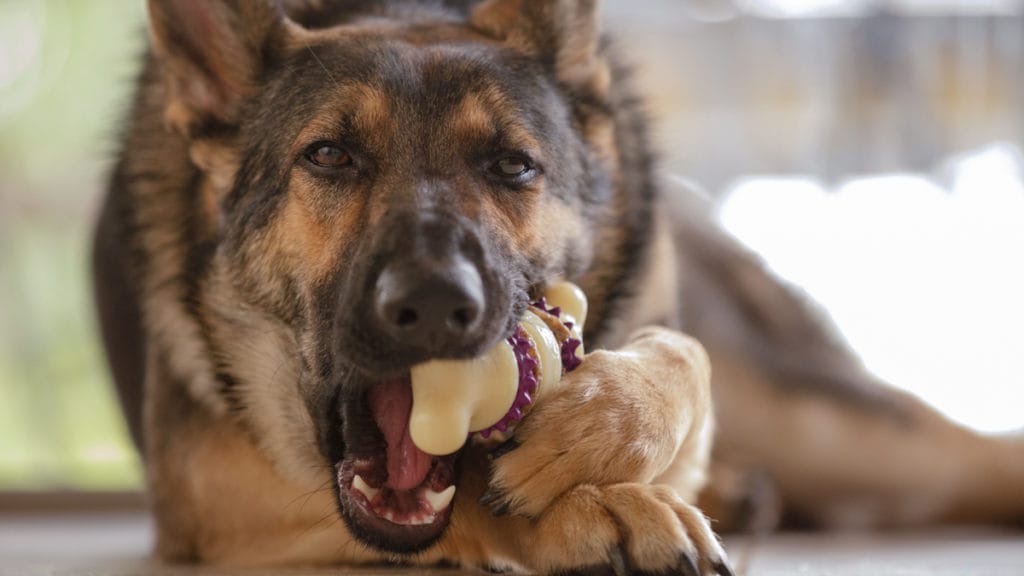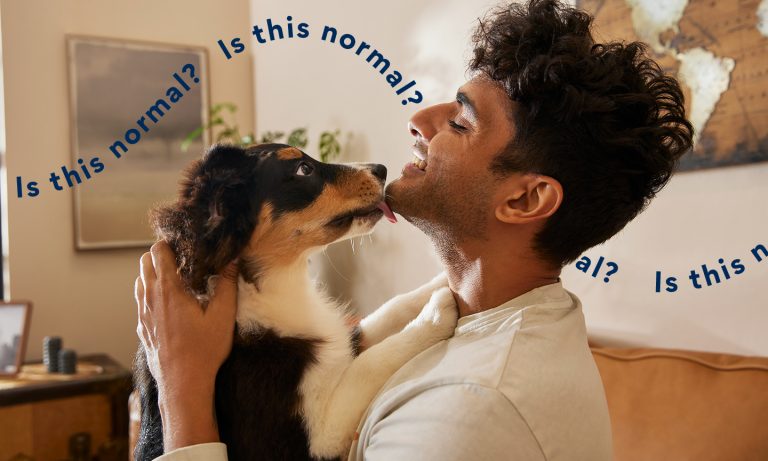We see every side of our pets: the good, the bad and the ugly. But have you ever seen the little green monster in your pets? Just like humans, dogs can experience jealousy over toys, food, and even their owner’s attention. Jealous dog behavior is often challenging to correct and can quickly turn into dog aggression if not properly addressed.
Anthony Newman, CPDT-KA and founder of Calm Energy Dog Training, shares the three types of jealous dog behaviors that can lead to dog aggression, plus tips for how to train a dog to be less reactive to these situations.
Jealous Dog Behavior: How to Train a Dog Against Moderate Guarding
When a dog is guarding a particular item, such as a bone, dog bed or bowl, and lunging, barking, snapping or trying to scare you or the “threat” away, Newman suggests a combination of two exercises: making the dog leave the item and removing it.
You can start the first by sending the dog away from the item by attaching a light leash to a PetSafe Martingale dog collar and leading him away from the item with a “leave it” command. As soon as he abandons his post and redirects his attention, reward him with a treat, drop the leash and use an “ok” command to allow him to happily return to the resource. Newman reminds us not to practice this exercise more than once or twice a day as it can make your dog nervous.
Secondly, once you begin to feel comfortable with the first exercise, practice taking the item from your dog and following the same reward routine of treating the dog and returning the item when he doesn’t react. By mastering the combination of exercises, you can begin to incorporate the training when your dog is posed with trigger situations where his jealous dog behavior may be provoked.
When It’s You That’s Guarding Your Jealous Dog
Sometimes, aggressive dog behavior can be perceived as guarding, when really, you are guarding him. “He’s putting up a show of aggression because he feels guarded by you,” clarifies Newman, “It isn’t him guarding you, but rather you’re permitting and promoting the aggression by (unintentionally) guarding your dog!” What does that mean? Newman goes on to explain that if your dog barks at the doorbell or lunges at a passing dog, and you pull back, your dog may see this as his aggression having caused the perceived threat to disappear. Your dog thinks, “The aggression worked!” and he feels encouraged to repeat the behavior.
So, how do you train your dog to safely pass by? Newman describes a dog’s thought process by saying, “Nine times out of ten in these cases, if you take control of your dog and of the situation, start leading your dog up to the threat—not being dragged by your dog—but you in front, leading, [he] starts to learn that his aggression isn’t needed and starts to be calmer in ‘trigger’ situations.” While this seems counterintuitive at first, it is most effective with leash-aggression, such as your dog barking at other dogs, kids on bikes, skateboarders, etc., or when he is guarding your home when a visitor or guest comes over, or even when the mail carrier comes by. If your dog is generally good with others in every other situation and not actually aggressive, chances are that he just needs to be reassured that there is no threat.
“He’s succeeded so far at convincing you (and others) that he’s aggressive; by doing so he’s manipulated you into protecting him from his perceived threats, and from the consequences of his reactivity,” explains Newman. “If you don’t allow the aggression to work, and instead take control and approach, in these cases, submissiveness ensues.” Ensuring that your dog is calm in his environment, or out on a walk, is the best way to successfully execute this exercise. Zuke’s Enhance Calming Chicken Formula Dog Treats and Vet’s Best Comfort Calm Soft Chews Dog Supplement help protect against environmental stress and reactivity. ThunderEssence Dog Calming Mist is also great to spray on his martingale dog collar or his dog harness before an upcoming trigger situation to help keep him relaxed throughout the exercise.
Serious Food Aggression
Full-blown resource guarding, also known as food aggression, can apply to any number of resources. While this dog behavior is rather rare, it can range from mild or moderate to severe, and can be a very difficult issue to address. “I always start by telling owners up front that in my more than 15 years’ experience with aggressive dogs of every size, age and breed, genuine resource guarding is something that can’t be fixed,” says Newman. “To the extent your dog will bite, puncture, and draw blood if someone approaches their food bowl, rawhide chew, tug toy, stick, squeaky ball or even dog bed, this reactivity ‘threshold’ won’t diminish, no matter what kinds of obedience training you work.”
Though full-blown resource guarding, when present, is usually engrained in the dog’s behavior, that doesn’t necessarily mean that nothing can be done about it. While a dog will continue to react when he feels that whatever is being guarded is at risk, the best way to avoid and prevent this jealous dog behavior is by preventing the situations that trigger it.
If this sounds like your dog, do not give up hope! Newman says that the best way to manage a true resource guarder is to not leave them with access to items that they perceive as valuable around potential threats. “In extreme cases, this means not being able to go to the dog park at all. Often, it means not bringing a squeaky ball; even more frequently, it means not bringing dog treats,” specifies Newman, “Don’t leave food bowls out at home with visitors, kids or other dogs. Don’t leave chews or dog toys out.” By eliminating items that your dog can become protective over, you remove the risk of dog aggression.
Working with a certified dog trainer will be the best way to learn how to safely handle your dog, act around him, and keep others safe. Keep in mind, however, that some resource guarding reactions are very serious and can be provoked by seemingly no cause, so remember to always take caution with yourself and those around you and your pup.
Share:













